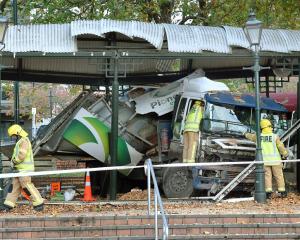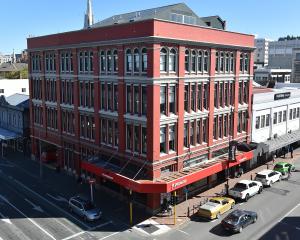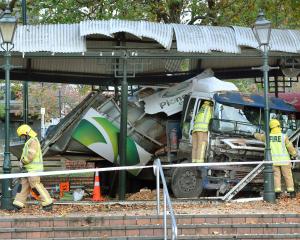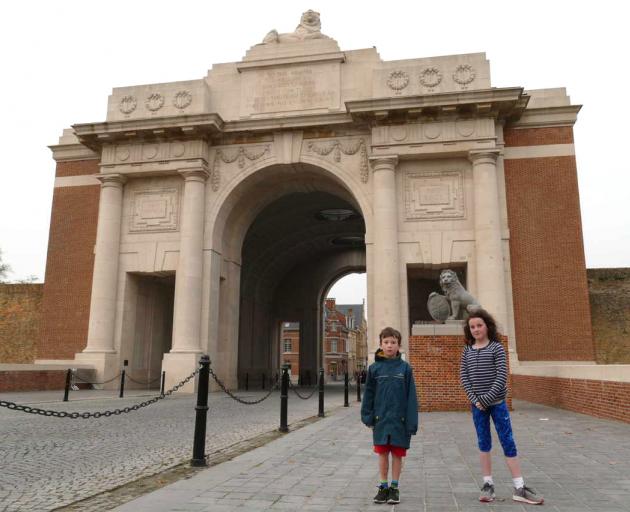
We were in Europe on the trip of a lifetime.
My wife Jo and I had taken three months’ leave from our jobs in Dunedin to take our children Emma (9) and Max (7) to visit some parts of America, Europe and the United Kingdom.
We wanted them to experience the world, rather than just see glimpses of it on television and the internet.
I had hoped we would visit some of the World War 1 cemeteries in Belgium but we had not planned anything specific.
If the opportunity arose the children would get to see for themselves the vast war grave sites and perhaps even find some Kiwi soldiers’ headstones.
It would enable them to appreciate the sacrifice so many young men had made for New Zealand.
Early in the trip we were in Paris and walked to the top of the Arc de Triomphe.

Inside was an exhibition of life-size photographs of the uniforms worn by the soldiers of each country that took part in World War 1.
Of course, we took particular notice of the New Zealand uniform and were surprised to see that the photograph displayed had been taken of a uniform worn by a member of the Otago Regiment.
A few weeks later we were staying in the glorious ancient city of Bruges, when early one morning I received an email from my mother in Alexandra. She said the Otago Daily Times had been publishing the death notices of Otago soldiers killed in World War 1.
She told me that my great-great-uncle Peter Gray, of the 3rd Battalion, Otago Regiment, had been killed in Belgium in 1917. He had been wounded in battle and had died on October 17.
I had only just woken up and drowsily reached over to grab my watch. The coincidence was incredible.
The date was October 17, 2017; one hundred years to the day since our relative had died in World War 1.
On that particular day we could have been anywhere, but we were in Bruges, Belgium and, remarkably as it turned out, only a 50-minute drive from where he was buried.
We had planned a day of sightseeing but clearly we could not let that important day pass without trying to find his grave, to pay our respects.
A quick search of the Commonwealth War Graves website told us where he was buried, including the row and plot number.
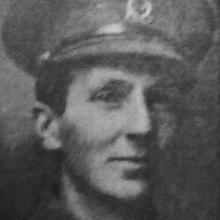
Google Maps did the rest and from there we embarked on a long trek to find a rental car company on the outskirts of town.
When we set off the sky was an unusual gold colour as huge sandstorms in the Sahara had blown particles of dust across parts of Europe.
We drove through vivid green fields, neat and orderly, dotted with farmhouses and the occasional tree, so different from the desolate landscape Private Peter Gray would have known 100 years before.
As we drove, we caught glimpses of military cemeteries seemingly scattered randomly among the fields, their white markers standing out against backdrops of fertile countryside.
Our first stop was in Ypres at the imposing Menin Gate, a memorial dedicated to the British and Commonwealth soldiers killed in the Ypres Salient and whose graves are unknown.
Each night at 8 o’clock The Last Post is played beneath the gate in their memory.
It was an unexpectedly moving experience to look at the tens of thousands of names inscribed on its walls of soldiers who have never been found. Numerous pristine wreaths placed beneath the columns provided further and immediate proof that they have not been forgotten.
Less than 7km west of Ypres in a quiet country lane we found the well-tended Brandhoek Military Cemetery No 3.
There were rows and rows of white rectangular headstones set into the grass. We found Peter Gray’s headstone next to another Otago Regiment soldier, Private A. H. Agnew. They had died on the same day. It seemed appropriate that they were together. Someone had left New Zealand Anzac Day poppies on the shrubs at the base of the markers.
They were lying loose, so we stood them upright against the headstones. It felt good to see something so familiar — a tiny piece of Kiwiana in a foreign land.
We told our children why it was important we visit this place, then we stood and bowed our heads as our daughter recited John McCrae’s hauntingly beautiful poem In Flanders Fields. Never has a smartphone come in more handy.
Of course, we didn’t know Peter Gray but we felt sure he would have appreciated having some members of his family, however distant, present to commemorate the 100th anniversary of his death.
After that we wandered around the cemetery and found some more graves of New Zealanders.
There were 18 of them in total. They had come so far, and although they didn’t know it at the time, they had died there for us. As we went to leave I put my hand on Peter’s headstone and read the inscription for a final time.
He had died when he was 27.I said: "Thanks".
It seemed so inadequate, such a meagre acknowledgment of what he had given up, but I could think of nothing more to say.A few weeks later on Armistice Day we planted a poppy in his honour at Westminster Abbey in an area set aside for New Zealand soldiers. At 11am my wife and daughter were in a department store on Piccadilly. They were taken by the solemnity with which everyone inside dutifully observed the two minutes’ silence commemorating the end of the war.
That would have been a fitting way to end our brief connection with Pte Gray but he was not finished with us yet.
Once back in New Zealand I took the children to Toitu Otago Settlers Museum to see the World War 1 exhibition about the Belgium battlefront called "The Belgians Have Not Forgotten".
It was the last day before the exhibition closed.
While reading aloud a wall-mounted information sheet about the battles in Ypres and Passchendaele, and reminding the children of the areas we had visited, we were tentatively approached by a man who had also been looking at the exhibition.
He said he hoped we didn’t mind but he had overheard us talking. He was from Belgium, and in fact lived near the area we had recently been to. We told him all about Peter Gray and showed him a photograph we had found among the books on display.
We were astonished to hear him recall that as a child he and his friends had played in Brandhoek Military Cemetery, and in the surrounding fields they had often found artefacts from the war such as bayonets and helmets.
The man’s brother-in-law was an expert on World War 1 and he offered to have him find out more for us about the battle that our relation would likely have been wounded in.
We swapped emails and true to his word less than two days later we received information stating that Peter Gray’s 3rd Battalion was involved in the failed attempt to take the Bellevue Spur on October 12, 1917.
It was New Zealand’s blackest day at Passchendaele; 843 New Zealand soldiers were either killed outright or mortally wounded. It was likely Peter Gray was one of them.
As we left Toitu the children and I talked about the amazing series of coincidences we had experienced that had led us to learn about Pte Gray. Emma said it was almost as if he wanted us to find out about him. I’d like to think she was right.




